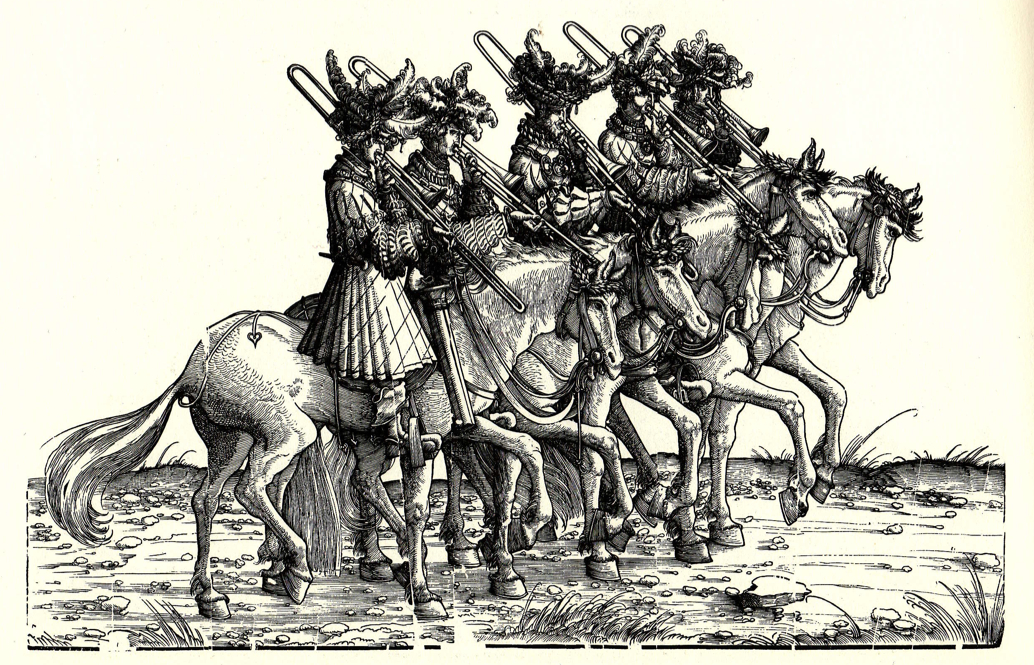
A woodcut from the series, “The Triumph of Maximilian,” showing a quintet of trombones on horseback (1526).
TROMBONE DUETS
c. 1500—Antoine Brumel, Benedictus qui venit “fuga ex una.” In Woolf, Duo Seraphim.
1533—In Wittenberg, Germany, a set of Georg Rhau’s part books, Symphoniae Jucundae (an anthology of motets), contains a manuscript note in one of the books saying certain works are “good on trombone etc.” Included in Adam Woolf’s Sackbut Solutions are 2 duets by Georg Rhau (Wittenberg 1545) that would fall within the spirit of that manuscript note.
1545—Munich: Ludwig Senfl, Ego ipse consolabor vos. In Woolf, Duo Seraphim.
1558—Venice: Orlando de Lassus, Specie tua et pulchritudine tua. In Woolf, Duo Seraphim.
1598—Venice: Giovanni Giacomo Gastoldi, No. 20. In Woolf, Duo Seraphim.
1598—Venice: Giovanni Giacomo Gastoldi, No. 19. In Woolf, Duo Seraphim.
1598—Venice: Giovanni Paolo Cima, No. 34. In Woolf, Duo Seraphim.
1598—Venice: Giovanni Dominico Rognoni, Canon in contrary motion. In Woolf, Duo Seraphim.
1604—Munich: Orlando de Lassus, Ricercar No. 21. In Woolf, Duo Seraphim.
1604—Munich: Orlando de Lassus, Justi Tulerunt Spolia. In Woolf, Duo Seraphim.
1604—Munich: Orlando de Lassus, Sicut Rosa. In Woolf, Duo Seraphim.
1609—Antwerp: Anonymous, O Maria mater pia. In Woolf, Duo Seraphim.
1619—London: Thomas Morley, Fantasia “La Girandola.” In Woolf, Duo Seraphim.
1619—London: Thomas Morley, Lo, here another Love. In Woolf, Duo Seraphim.
1619—London: Thomas Morley, Go ye my canzonets. In Woolf, Duo Seraphim.
1619—London: Thomas Morley, Fire & Lightning. In Woolf, Duo Seraphim.
1620—Venice: Giovanni Battista Riccio, Maria stabat ad monumentum. In Woolf, Sackbut Solutions.
1620—Venice: Giovanni Battista Riccio, Currebant duo. In Woolf, Duo Seraphim.
1625—Venice: Adriano Banchieri, Concerto di dui Angioletti in Dialogo. In Woolf, Duo Seraphim.
1629—Nuremberg, Germany: Numerous works from Biagio Marini’s instrumental collection, Sonate, sinfonie, canzoni, passemezzi…, specify trombone, including Sonata octava (2 bassoons or bass trombones, continuo), Sonata nona (2 bassoons or bass trombones, continuo) (Collver 60; Selfridge-Field, Instrumentation; Winkler 301). For additional works from the same collection, see the following categories, below: “Trombone Quartets,” and “Trombone and Violin(s),” and “Trombone with Various Other Ensembles.”
1650—Naples: Andrea Falconieri, Passacalle. In Woolf, Duo Seraphim.
1662—London: Richard Dering, Duo Seraphim. In Woolf, Duo Seraphim.
1657—Rome: Giuseppe Giamberti, Duo XXI. In Woolf, Duo Seraphim.
1657—Rome: Giuseppe Giamberti, Duo XIV “Solfeggiamento.” In Woolf, Sackbut Solutions.
1657—Rome: Giuseppe Giamberti, Duo XXIX. In Woolf, Sackbut Solutions.
1657—Rome: Giuseppe Giamberti, Duo XXIX “La Sol Fa Re Mi.” In Woolf, Sackbut Solutions.
TROMBONE TRIOS
1612—In Bologna, Italy, Adriano Banchieri composes his Moderna armonia di canzoni alla francese. In the foreword, Banchieri suggests trombone consort as one of many options for performing the work (Collver 42). Canzone for 3 trombones—Performance edition available (Tezak).
1697—Daniel Speer’s 2 sonatas for 3 trombones and continuo are published in the second edition of his Grundrichtiger Unterricht der musikalischen Kunst oder Vierfaches musikalisches Kleeblatt. I own Sonata 1 (in Woolf, Sackbut Solutions).
c. 1795—François René Gebauer writes Six Trios (from 50 Leçons pour les Trombonne Basse, Alto & Tenor). Performance edition available (Editions Musicales) .
TROMBONE QUARTETS
1505—Venice, Italy: In a letter written by Giovanni Alvise, a city musician, Alvise mentions a piece arranged for trombones alone, an arrangement for 4 trombones and 2 cornetti, and another for trombones and shawms (no specific composers or titles are given). The arrangement for trombones alone may constitute the earliest record of a pure trombone consort piece (Polk, German 73). Precise music and number of trombones unknown.
1552—Treviso, Italy: Giovanni Nasco sends music, including an arrangement for trombones, to Accademia Filarmonica in Verona: “Now having newly composed these little things at the request of the magnificent Monsignor Miani, Venetian gentleman, that is the madrigal ‘Donna vostra belta,’ the other with low voices arranged for the trombones…” (Tim Carter, Music in Late 163; Elias, Musical Performance). Precise number of trombones unknown.
1572—Venice, Italy: Tomás Luis de Victoria, O vos omnes (transposed alla quarta bassa):
1612—In Bologna, Italy, Adriano Banchieri composes his Moderna armonia di canzoni alla francese. In the foreword, Banchieri suggests trombone consort as one of many options for performing the work (Collver 42). L’Ardina for 4 trombones—Performance edition available (Cimmaron).
1621—In Munich, Germany, at the Bavarian court, cornettist and trombonist Giulio Martino Cesare writes a collection of 28 instrumental and vocal works called Musicali Melodie. It includes “La Bavara,” for 4 trombones (Whitwell Catalog Baroque 122; Collver 47).
1636—In Venice, Biagio Marini, violinist at St. Mark’s, writes Canzon (from Sonate, symphonie) for 4 trombones and continuo. Performance edition available (Ens Pub/Howard Weiner).
1658—Johann Georg Franz Braun, Canzonato (Carter, Performer’s Guide 17C, 128). Performance edition available (Max Hieber).
1685—Daniel Speer writes Sonata (from Neu-gebachene Taffel-Schnitz) for 4 trombones and continuo (Speer).
TROMBONE CHOIR (5 or MORE)
1568—In Munich, Germany, during a banquet celebrating the marriage of Wilhelm V to Renata of Lorraine, trombone participates in numerous pieces, including a madrigal by Alessandro Striggio for 6 trombones (one of which plays an octave lower than usual) (Haar 251, 253).
c. 1600—Germany: Moritz von Hessen, Pavan for 5 trombones and continuo, from a collection of pavans, galliards, and intradas (Carter, Performance in 17C, 129; Whitwell, Catalog Baroque 136). Performance edition available (Ensemble Publications).
1608—In Venice, Tiburtio Massaino, maestro di cappella at Lodi from 1600 to 1608, writes for 8 trombones and continuo in Canzon 33 per 8 Tromboni from Canzoni per sonare con ogni sorte di stromenti (Massaino).
1649—Johann Hentzschel, Canzon for 8 trombones and continuo (Carter, Performance in 17C, 129). Performance edition available (R. Ebner).